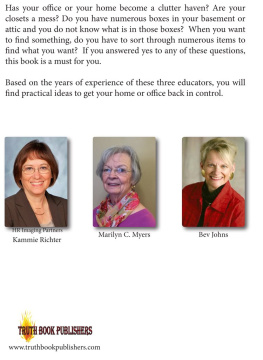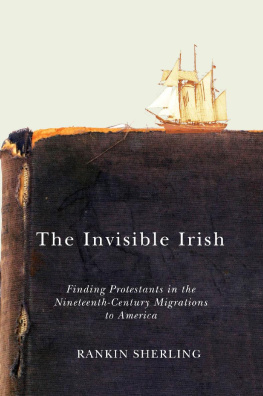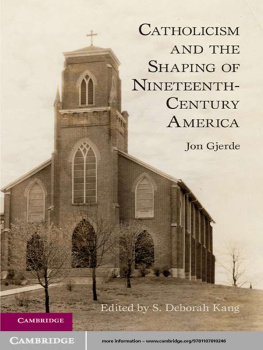At Home in Nineteenth-Century America
At Home in Nineteenth-Century America
A Documentary History
Amy G. Richter
New York University Press
New York and London
NEW YORK UNIVERSITY PRESS
New York and London
www.nyupress.org
2015 by New York University
All rights reserved
References to Internet websites (URLs) were accurate at the time of writing. Neither the author nor New York University Press is responsible for URLs that may have expired or changed since the manuscript was prepared.
ISBN: 978-0-8147-6914-0 (paperback)
ISBN: 978-0-8147-6913-3 (hardback)
For Library of Congress Cataloging-in-Publication data, please contact the Library of Congress.
New York University Press books are printed on acid-free paper, and their binding materials are chosen for strength and durability. We strive to use environmentally responsible suppliers and materials to the greatest extent possible in publishing our books.
Manufactured in the United States of America
10 9 8 7 6 5 4 3 2 1
Also available as an ebook
For Jim and Simon
Contents
At Clark University, I am grateful to the History Department and Higgins School of Humanities for funding my research and supporting the purchase of images and permissions. In addition to material support, my colleagues in the History Department consistently offer me multiple examples of how to be a dedicated teacher-scholar; I am truly thankful for this gentle and invaluable encouragement. I feel particularly fortunate that I got to know Jack Larkin through his affiliation with our department. What a treat to swap sources and stories of home with him! Outside of the History Department, I thank my friends and Clark colleagues Sarah Buie, Kristen Williams, and Kristina Wilson for their interest in my work and their willingness to share ideas, insights, and enthusiasm.
I owe a considerable debt to the students enrolled in my first-year seminar in Fall 2008. That course was the first iteration of this volume, and I have thought of you and our work as I have put the pieces together. Several graduate students have also taken time to think through documents and consider the themes of nineteenth-century American domesticity with me. Special thanks to Lindsay Allen, Diane Boucher, Madeline DeDe-Panken, and Melinda Marchand. Finally, there would be no book without the dedication and support of Diane Fenner in the History Department and Lisa Gillingham, Jennifer McGugan, and Sara Raffo at the Higgins School of Humanities. Thank you for being so good at what you do and for giving me time to write and revise when I needed it.
I have benefited from the hard work, skill, and patience of librarians, archivists, and staff at the following institutions: the American Antiquarian Society, the Library of Congress, the Minnesota Historical Society, the Nebraska State Historical Society, and the New York Public Library. Special thanks to Mary Hartman, Holly Howes, Rachael Shea, and Irene Walch at Clark Universitys Goddard Library. Elizabeth Watts Pope and Jaclyn Donovan Penny at the American Antiquarian Society made all the difference with their knowledge of the AASs holdings and eagerness to share its rich collections.
I feel fortunate that this book found its home at NYU Press. I am grateful to Debbie Gershenowitz for saying yes and shaping the volume in its early stages. She and Gabrielle Begue offered encouragement and kept me on track. Clara Platter saw me through the final rounds of revision, and Constance Grady patiently helped tend to the details. I am especially grateful to the three anonymous reviewers. It is remarkable to have strangers pay such attention to ones work and to provide insightful and careful comment. The shape of the book changed in response to the readings by the first two reviewers, one of whom commented on the penultimate draft as well. A third reader came in late in the game, helped me see the volume afresh, and pushed for a few more documents. Next Andrew Katz did a heroic job copyediting the manuscript with such care for the primary documents and their original linguistic quirks. And just when I thought the work was done, Dorothea Halliday, Edith Alston, and Charles B. Hames made sure the final steps went smoothly. Thank you all!
The last thank-yous are for my family. Thank you to my mother, Adele Richter, and my in-laws, Janet and Jerry Eber, for your tireless and loving interest in what I do. Finally, Jim and Simon, every day you remind me of the richness of home life as we negotiate work and play, public and private, family ties and the marketplace together. I am grateful for the joy of it all.
At Home in Nineteenth-Century America
According to the historian Elsa Barkley Brown, History is everybody talking at once, multiple rhythms being played simultaneously.... In fact, at any given moment millions of people are talking all at once. Throughout the nineteenth century, many Americans were talking all at once about home; they were speaking to and past one another and often meant very different things. At Home in Nineteenth-Century America focuses on the home as a physical site and cultural ideal in order to help re-create some of this unwieldy conversation. Using primary documents, it revisits the variety of places that Americans called homemiddle-class suburban houses, slave cabins, working-class tenements, frontier dugouts, urban settlement housesand explores the shifting interpretations and experiences of these spaces from within and without.
Rather than offering a history of material culture or architectural styles, this volume uses the home as a synthetic tool to pull together stories of nineteenth-century America. The result is less a tidy account of shared domestic values or a straightforward chronology of change over time than an opportunity to eavesdrop on a wide-ranging conversation that included a diverse group of historical actors: a domestic servant and Herman Melville, a newlywed housewife and W. E. B. Du Bois, an interior designer and Theodore Roosevelt, all of whom contemplated the power and boundaries of the American home. When brought together, these voices offer an intimate yet broad view of nineteenth-century American history.
And no wonder: few institutions were as central to nineteenth-century American culture. Beginning in the 1820s, the home emerged as a sentimental and celebrated space apart from the public world of commerce and politics, competition and corruption. Indeed the emergence of the An imperfect description of reality, the domestic ideal was powerful nonetheless. Those excluded from it sought to claim respectable domesticity as their own, and those constrained by it stretched its boundaries to encompass an array of public concerns and institutions. In sum, the Victorian home literally embodied the power and tested the limits of nineteenth-century American values to shape everyday spaces and experiences.
As depicted in many documents, nineteenth-century homes and notions of domesticity seem simultaneously distant and familiar. This sense of surprise and recognition is ideal for the study of history, preparing us to view the past with curiosity and empathy. Exploring the spatial manifestations of American Victorianism inspires comparisons to the spaces we inhabit todaymalls, movie theaters, college campuses, our own homesand encourages us to see the lingering imprint of past ideals. The concreteness of studying houses, parks, and city streets helps frame sophisticated questions. For example: If women of all classes entered into public spaces in order to keep house, why was middle-class white femininity rooted so deeply in the home? How did men inhabit homes and interpret domesticity in both private and public life? How did class and racial differences shape domestic ideals, and in turn, how did ideals of domesticity both uphold and undermine these social divisions? Were domesticated public spaces ever truly public? How did differing interpretations of home create or circumscribe cultural or political power for various social actors? Through such questions, we move from the literal spaces to the ideals that shaped themfrom homes to domesticity, from domesticity to politics and culture.









